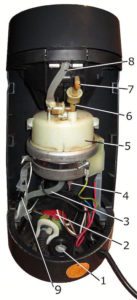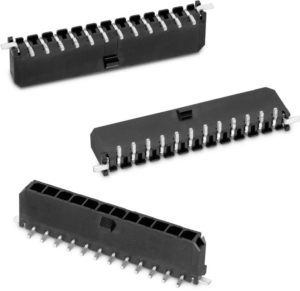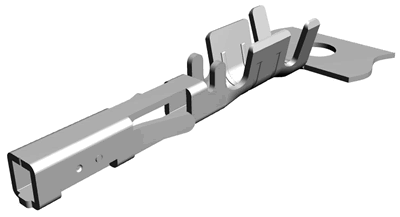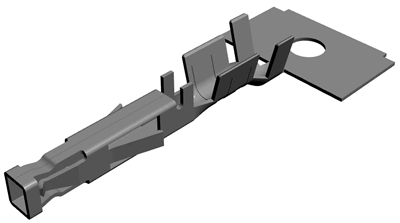How to Create a Durable Low-Force Crimp Contact
Products ranging from appliances to vehicles feature crimp contact plug connectors that are hard to access and easy to damage. In the event of a repair, a more durable connector is needed.
By Andreas Aigner, Product Development Manager, Würth Elektronik eiSos
Although they are really designed for permanent connections, plug connectors with crimp contacts occasionally have to be disconnected. To avoid creating a trial of strength for the maintenance technician, who then runs the risk of damaging the plug connector, alternative designs can reduce the insertion and pulling force needed to disconnect these components if the need arises.

In this Senseo coffee maker, #4 is the electric connector for the brewing unit/heating chamber. (Image by Cschirp)
Household appliances are one example of permanent connections that require occasional disconnection. Appliance manufacturers have to take the possibility of servicing into consideration as they develop these products. This means that components prone to wear and defects, such as those found in the brewing unit of a coffee machine, have to be easily accessible. It is important to use components that are not easily damaged during the repair process to reduce additional costs. Crimp plug connectors with more than 10 pins are examples of such components. Equipped with standard contacts, they can only be disconnected with great difficulty; with 24 pins they are almost impossible to disconnect. Given an installation or repair situation in which the electronics are difficult to access, smaller numbers of pins are enough to hamper disconnection of the wire-to-board connection. In these situations, it can often be impossible to use tools, so there is only one solution: to tug on the cable. Of course, this typically damages the plug connector’s mechanics.
The electronics in many vehicles are fit into areas that are difficult to reach as well, both to protect them from the elements and to prioritize access to the larger mechanical parts that need more frequent maintenance. Deutsche Bahn, or German Railway, encountered this problem during maintenance work on the door controls of their carriages. The cramped conditions made it difficult to access the connectors. With an eye towards avoiding difficulty in the future, the company sought a crimp plug connector with the same electrical properties as the one previously used, but with features that made it easier to connect and disconnect. Even so, it must still maintain the integrity of the connection to withstand exposure to strong vibrations during travel. Würth Elektronik eiSos modified the standard crimp contact on its WR-MPC3 series to meet this customer’s need, and in doing so created a solution that delivers the same performance but offers much more usability and endurance.

Wurth’s WR-MPC3 Low-Force Crimp Contacts combine rugged, reliable electrical and mechanical performance with easier connection and disconnection capabilities.
The secret of the low-force contact’s reduced insertion and pulling forces lies in the modified contact geometry. Whereas the standard design has pronounced contact points, the low-force version is flexible as a result of its spring contacts. This flexibility required a change of material to achieve good relaxation behavior and consistent contact pressure, and to counteract fatigue. Nevertheless, both have the same electrical properties: a maximum current carrying capacity of 5A (AWG 20–22) or 4A (AWG 24), as well as a voltage of 250V. On account of the larger number of contact points, the contact resistance for the standard version is a maximum of 10mΩ and the low-force contact is 20mΩ.
What is decisive, however, is the huge difference in the insertion force — which, for the standard contact, is a maximum of 8N and, for the low-force contact, is a maximum of 4N — and the pulling force that has to be applied to the standard design (a minimum of 3.7 N) versus the low-force counterpart (1.5–3N). The new contact design achieves a reduction in the insertion force for a single contact of 50%, and the pulling force is reduced by 20–50%.
The improved handling of the plug connector is particularly apparent from the example of a 24-pin plug connector: In the most favorable case of disconnection with standard design contacts, a force of 88.8N (24 × 3.7N) is necessary. A force of 72N (24 × 3N) has to be applied in the least favorable case with a low-force contact. So there is an effectively reduced application of force of 16.8N.
Device manufacturers already profit from the low-force crimp contacts in product development. Since the connections often have to be made and disconnected again here, the high friction insertion and disconnection is considered troublesome. Nothing changes for the suppliers of pre-fitted cables: The low-force contacts can be crimped with the same machine as the standard design.
[box border=”full”]Comparison of Pulling Forces for Standard and Low Force Crimp-Contacts
The connection was disconnected 10 times and the respective pulling forces required were measured. With a mean value of 0.22N for the low-force crimp contact and an average pulling force of 1.2N for the standard contact, there is a mean force reduction of 0.98N.

Figure 1. The standard crimp contact has a rigid contact sleeve.

Figure 2. The sleeves on the low-force crimp contacts are equipped with springs that ease insertion and disconnection
[/box]
Recently posted:
[related_posts limit=”10″]






